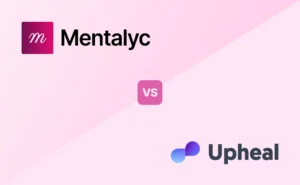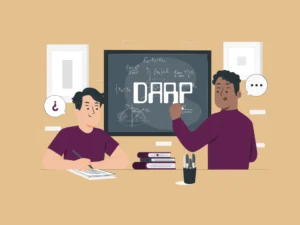ICD-10-CM Code for Major Depressive Disorder is F32.9
- Billing Code: F32.9 is a specific code used for billing purposes in the American ICD-10-CM system (effective October 1, 2023).
- Diagnosis Indicator: This code signifies “Depression, unspecified.”, also referred to as ICD-10 depression unspecified.
- International Variation: Be aware that international versions of ICD-10 may utilize different codes for depression diagnoses.
For clinicians, understanding ICD-10 codes for depression supports precise record-keeping, treatment planning, and smooth insurance claims. In this article, you’ll learn what the F32.9 code means, when to use it, and how to document it confidently.
Struggling to keep your notes clear, compliant, and connected to diagnoses? **Mentalyc** does the heavy lifting by capturing diagnostic indicators based on chosen ICD codes. It helps you keeps documentation consistent, clear, and ready for insurance, audits, or supervision.
Understanding ICD-10 Codes for Depression
The primary ICD-10 code for depression is F32, which corresponds to a single episode of Major Depressive Disorder (MDD). Depression can manifest in different ways and have varying characteristics, so further coding specificity is often necessary.
ICD-10 Specifiers and Subtypes for Major Depressive Disorder
Additional coding for accurate documentation may include:
F32.0: Major depressive disorder, single episode, mild
F32.1: Major depressive disorder, single episode, moderate
F32.2: Major depressive disorder, single episode, severe without psychotic features
F32.3: Major depressive disorder, single episode, severe with psychotic features
F32.8: Other specified major depressive disorder
F32.9: Major depressive disorder, single episode, unspecified
These codes allow for the precise documentation of severity and specific features, supporting effective treatment planning and helping clinicians reference the F32.9 depression code when applicable.
Coding for Recurrent Episodes (Recurrent Depression Codes)
Depression often presents as recurrent episodes. The ICD-10 codes for recurrent depressive disorder (F33) allow for the documentation of repeated occurrences and include:
F33.0: Major depressive disorder, recurrent, mild
F33.1: Major depressive disorder, recurrent, moderate
F33.2: Major depressive disorder, recurrent, severe without psychotic features
F33.3: Major depressive disorder, recurrent, severe with psychotic features
F33.8: Other specified recurrent depressive disorder
F33.9: Recurrent depressive disorder, unspecified
Using these ICD-10 codes for recurrent depression ensures that clinicians accurately capture the nature of recurrent depressive episodes and remain consistent with the ICD-10 coding for mental health documentation standards.
Coding for Depression with Specific or Atypical Features
Some clients with depression exhibit atypical features, such as hypersomnia, hyperphagia, mood reactivity, or leaden paralysis. Code those features as follows:
Coding Depression with Atypical or Psychotic Features
F32.8: Other specified major depressive disorder, with atypical features
F32.9: Major depressive disorder, single episode, unspecified, with atypical features
When clients experience psychosis alongside depression, use the following codes:
F32.3: Major depressive disorder, single episode, severe with psychotic features
F33.3: Major depressive disorder, recurrent, severe with psychotic features
Postpartum Depression ICD-10 Codes
Postpartum depression affects women following childbirth. Accurate coding is necessary to distinguish it from other forms of depression, making the ICD-10 code for postpartum depression essential for proper classification:
F32.0: Major depressive disorder, single episode, mild, postpartum
F32.1: Major depressive disorder, single episode, moderate, postpartum
F32.2: Major depressive disorder, single episode, severe without psychotic features, postpartum
F32.3: Major depressive disorder, single episode, severe with psychotic features, postpartum
F32.8: Other specified major depressive disorder, postpartum
F32.9: Major depressive disorder, single episode, unspecified, postpartum
ICD-10 Codes for Depression (Quick Reference Table)
| Code | Diagnosis Description | Episode Type / Severity | Notes |
| F32.0 | Mild depressive episode | Single episode | Minimal functional impairment; symptoms meet criteria for mild depression. |
| F32.1 | Moderate depressive episode | Single episode | Noticeable impact on daily functioning; no psychotic symptoms. |
| F32.2 | Severe depressive episode without psychotic symptoms | Single episode | Major impairment; no delusions or hallucinations present. |
| F32.3 | Severe depressive episode with psychotic symptoms | Single episode | Severe depression with psychotic features such as delusions or hallucinations. |
| F32.4 | Mild depressive episode, in partial or full remission | Single episode | Used during recovery or improvement phase. |
| F32.9 | Depression, unspecified | Single episode | Use when details about severity or type are insufficient. |
| F33.0 | Recurrent depressive disorder, current episode mild | Recurrent | Multiple depressive episodes; current episode mild. |
| F33.1 | Recurrent depressive disorder, current episode moderate | Recurrent | Ongoing or repeated episodes; moderate severity. |
| F33.2 | Recurrent depressive disorder, current episode severe without psychotic symptoms | Recurrent | Severe impairment but no psychosis. |
| F33.3 | Recurrent depressive disorder, current episode severe with psychotic symptoms | Recurrent | Severe depression with delusions or hallucinations. |
| F33.4 | Recurrent depressive disorder, currently in remission | Recurrent | Used when the client is in partial or full remission. |
ICD-10 System Overview – How to Document and Code Depression Accurately
The ICD-10 is a comprehensive coding system developed and maintained by the World Health Organization (WHO, 1993). It provides clinicians with a standardized language for documenting and coding depression and other psychiatric diagnoses in both clinical and billing settings.
The ICD-10 uses an alphanumeric structure to organize disorders into chapters and categories, ensuring precision and consistency across healthcare systems worldwide. Accurate coding is essential not only for proper diagnosis but also for treatment planning, insurance reimbursement, and public health research.
For mental health professionals, clear and consistent documentation is key to coding effectively. Solutions like Mentalyc can support this process by generating structured, HIPAA-compliant notes and treatment summaries, helping clinicians maintain accuracy and efficiency while meeting documentation standards.
Comorbid Conditions and Dual Coding for Depression
Depression often co-occurs with other mental health conditions, such as anxiety disorders, substance use disorders, or personality disorders. It’s important to accurately document comorbid conditions for treatment planning and insurance purposes. Depression comorbid conditions ICD-10 codes should be used in addition to the primary depression diagnosis.
The Role of Clinical Documentation
Accurate ICD-10 coding for depression relies on comprehensive clinical notes. Mental health professionals must provide a detailed description of the client’s symptoms, duration of the episode, and relevant specifiers, subtypes, or features. This information serves as the foundation for selecting the appropriate code(s).
Progress notes are crucial for documenting the course of depression, detailing the client’s response to treatment, symptom changes, and overall progress. These observations inform subsequent coding and treatment decisions, improving the use of depression billing codes across client records.
Examples of Correct ICD-10 Coding for Depression Using Practical Scenarios
Coding for a Single Episode of Depression
– A 28-year-old male presents with persistent sadness, loss of interest, and insomnia over the past nine weeks. After a clinical evaluation, he is diagnosed with Major Depressive Disorder, single episode, moderate. The appropriate ICD-10 code is F32.1.
Coding for Recurrent Depressive Episodes
– A 54-year-old female has experienced four separate episodes of severe depression over the past six years, with each episode lasting approximately seven months. She reports she experiences hallucinations and paranoia during these episodes. The appropriate ICD-10 code is F33.3, Major Depressive Disorder, recurrent, severe, with psychotic features.
Coding for Postpartum Depression with Atypical Features
– A 29-year-old female presents with postpartum depression marked by mood reactivity, increased appetite, and disrupted sleep. The appropriate ICD-10 code is F32.9, Major Depressive Disorder, single episode, unspecified, with atypical features, postpartum.
Common Coding Errors and How to Avoid Them
| Common Coding Error | Description | Potential Impact | How to Avoid It |
| Overgeneralization (F32.9 overuse) | Using unspecified code when more detailed information is available. | Leads to vague documentation and possible claim denial. | Use the most specific code matching the client’s episode type and severity. |
| Neglecting comorbid conditions | Failing to include additional diagnoses like anxiety or substance use. | Incomplete client record; inaccurate billing. | Document and code all relevant comorbidities. |
| Under coding or misclassification | Assigning a less severe code than clinically indicated. | Underestimates condition severity; impacts treatment and reimbursement. | Review full diagnostic criteria and assess symptom severity accurately. |
| Mismatch between clinical notes and billing code | Diagnosis in documentation doesn’t match billing submission. | Causes insurance claim rejections or audits. | Ensure alignment between clinical records and coded data. |
| Outdated coding references | Using older or incorrect ICD versions. | Noncompliance with current standards | Regularly update coding manuals and stay informed about ICD-11 changes. |
| Incomplete documentation | Missing key diagnostic details or episode specifiers. | Weakens treatment planning and legal compliance. | Include duration, severity, and specifiers in clinical notes. |
Accurate and precise coding of depression is paramount because these codes serve as a universal language that allows for efficient communication, appropriate depression code for insurance claims, ongoing research, and effective treatment planning.
However, this process involves challenges and potential pitfalls, which can have significant consequences. Below are some common coding challenges:
Overgeneralization (F32.9 overuse)
This happens when a clinician diagnoses depression without noting important details such as severity, specific features, or episode patterns. Accurate mental health ICD-10 documentation requires a clear understanding of the client’s unique presentation. When details are overlooked, it can affect treatment planning, progress tracking, and proper insurance reimbursement.
Neglecting comorbid conditions
Neglecting to document comorbid conditions can result in incomplete client records. Mental health professionals must always consider the presence of other mental health disorders that may require separate coding and distinct treatment strategies.
Under coding or misclassification
Under coding or misclassification arises because of a lack of awareness of the full diagnostic criteria or inadequate evaluation. Failing to assign the appropriate codes can lead to under treatment, delayed access to care, and inadequate insurance coverage.
Mismatch between clinical notes and billing code
A mismatch between clinical assessment and coding can lead to confusion, inefficiency, and potential disputes with insurance companies. Mental health professionals must ensure the codes accurately reflect the client’s mental health condition and clinical assessment findings. Using the correct depression code for insurance claims not only supports appropriate reimbursement but also maintains the integrity and clarity of clinical documentation.
Incomplete documentation
Documentation integrity is eroded when there is incomplete or inconsistent documentation, which can hinder the diagnostic process and create challenges in treatment planning and reimbursement. Rigorous standards for documentation integrity must be maintained to ensure that the codes align with the client’s clinical presentation.
Outdated coding references
Mental health professionals must stay informed about changes in coding systems, including the transition from ICD-10 to ICD-11, to ensure coding practices remain current and in compliance. Mental health professionals must have a deep understanding of the ICD-10 coding system, so regular training and updates are essential to stay informed about revisions and changes.
The Importance of Accurate ICD-10 Coding in Mental Health
Accurate ICD-10 code for depression ensures proper diagnosis, treatment, and documentation while also contributing to accurate epidemiological data. By understanding the nuances of coding, mental health professionals can better serve their clients, navigate the complexities of the mental health system, and contribute to advancing the understanding of this common and debilitating mental health condition.
Streamline Your Clinical Documentation with Mentalyc
Mentalyc is an AI-powered platform designed specifically for mental health professionals to simplify clinical documentation. With advanced automation, it helps therapists create accurate therapy notes and treatment plans in minutes, saving hours of administrative work each week.
Mentalyc’s notes ensure compliance with HIPAA standards, maintain clinical precision, and support accurate ICD-10 coding for mental health to streamline insurance reimbursement. Whether you’re a solo practitioner or part of a group practice, Mentalyc empowers you to focus more on client care and less on paperwork.
Frequently Asked Questions (FAQs) About ICD-10 Codes for Depression
1. What is the ICD-10 code for depression?
The primary ICD-10 code for depression is F32.9, which indicates Depression, unspecified. It is used when a depressive episode is present but lacks sufficient detail to classify the type, severity, or specific features. Other related codes include F32.0 (Mild depressive episode), F32.1 (Moderate depressive episode), and F32.2–F32.3 (Severe depressive episodes with or without psychotic symptoms).
2. How to code depression for insurance reimbursement?
When coding depression for insurance reimbursement, always assign the most specific ICD-10 code that matches the client’s clinical presentation. Ensure that the diagnosis corresponds with DSM-5 criteria and that specifiers (such as severity or recurrence) are documented in the clinical notes. Insurance companies often require detailed information, so include the primary diagnosis, comorbid conditions, and relevant ICD-10-CM depression code (e.g., F32.9 or F33.x).
3. What are some depression coding examples for therapists?
- F32.0 – Mild depressive episode
- F32.1 – Moderate depressive episode
- F32.2 – Severe depressive episode without psychotic symptoms
- F33.0 – Recurrent depressive disorder, current episode mild
- F33.2 – Recurrent depressive disorder, current episode severe without psychotic symptoms
These examples help therapists select precise codes that reflect the client’s symptoms and episode pattern.
4. What are ICD-10 specifiers for major depressive disorder?
ICD-10 specifiers allow clinicians to describe important features of Major Depressive Disorder (MDD). Common specifiers include:
- Severity: Mild (F32.0/F33.0), Moderate (F32.1/F33.1), or Severe (F32.2/F33.2)
- With psychotic symptoms: F32.3 or F33.3
- Remission status: In partial remission (F33.4) or in full remission (F33.42)
- Recurrent vs. single episode: Single (F32.x) or recurrent (F33.x)
- These help improve diagnostic accuracy and treatment planning.
5. What are the ICD-10 codes for recurrent depressive disorder?
Recurrent depressive disorder is coded under F33 in ICD-10. Specific examples include:
- F33.0 – Current episode mild
- F33.1 – Current episode moderate
- F33.2 – Current episode severe without psychotic symptoms
- F33.3 – Current episode severe with psychotic symptoms
- F33.4 – In remission (partial or full)
The F33.1 recurrent depressive disorder code is used when the client presents with a moderate current episode and has a documented history of previous depressive episodes. These codes indicate that the client has experienced multiple depressive episodes over time.
6. How to document depression accurately in clinical notes?
Accurate documentation should include:
- Diagnosis and ICD-10 code (e.g., F32.9 or F33.1)
- Symptom presentation (duration, severity, and functional impact)
- Specifiers (e.g., with anxious distress, psychotic features)
- Treatment plan and clinical rationale
- Response to interventions or progress over time
Thorough documentation supports clinical accuracy, insurance compliance, and continuity of care.
7. What are the ICD-10 coding guidelines for mental health professionals?
Mental health professionals should follow these ICD-10 coding guidelines:
- Use the most specific code available.
- Ensure the diagnosis aligns with DSM-5 criteria.
- Record comorbidities and secondary diagnoses.
- Update codes when symptoms change or improve.
- Stay informed about ICD-11 updates and coding transitions.
These practices promote ethical and accurate diagnostic reporting.
8. What is the difference between F32 and F33 depression codes?
The F32 codes refer to a single depressive episode, whereas F33 codes indicate a recurrent depressive disorder with multiple episodes over time.
- Example: F32.1 = Moderate single episode; F33.1 = Moderate recurrent episode.
This distinction affects treatment planning, prognosis, and insurance documentation.
9. What are common coding challenges for depression diagnosis?
Common challenges include:
- Overgeneralization (using F32.9 too frequently)
- Undercoding or misclassification due to incomplete evaluation
- Neglecting comorbid conditions, such as anxiety or substance use
- Documentation inconsistencies between clinical notes and billing forms
- Lack of training in ICD-10 updates or specifiers
Awareness of these pitfalls, especially in coding for depression and anxiety, ensures more accurate coding, better treatment outcomes, and proper reimbursement.
References:
- World Health Organization (WHO). (1993). The ICD-10 classification of mental and behavioral disorders. World Health Organization.
- Centers for Disease Control and Prevention (CDC). (2023). Depression. Retrieved from https://www.cdc.gov/nchs/fastats/depression.htm
Why other mental health professionals love Mentalyc

“A lot of my clients love the functionality where I can send them a summary of what we addressed during the session, and they find it very helpful and enlightening.”
Therapist

“It’s so quick and easy to do notes now … I used to stay late two hours to finish my notes. Now it’s a breeze.”
Licensed Professional Counselor

“By the end of the day, usually by the end of the session, I have my documentation done. I have a thorough, comprehensive note … It’s just saving me hours every week.”
CDCII

“It takes me less than 5 minutes to complete notes … it’s a huge time saver, a huge stress reliever.”
Licensed Marriage and Family Therapist







